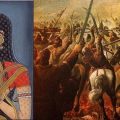Nalanda: 9 Million Books Burnt in 1193 by Bakhtiyar Khilji

Nalanda University! The very utterance of this name will transport you to India’s ancient terrain of knowledge. This ancient center of higher learning, located in Bihar (in the ancient kingdom of Magadha), is India’s second oldest university after Takshila. Spread over an area of 14 hectares, it was a principal seat of learning from the last century of BCE till (the Turkish invasion of) 1193, attracting students from as far as Tibet, China, Greece, and Persia. While datable history of Nalanda University as per literary records and inscriptions started from the Gupta period, dating back to at least 2100 years, archaeological excavations and further discoveries prove it existed since the period beyond 1200 BCE.
All of the ancient Indian universities including Nalanda followed highly formalized methods of Vedic learning. It was the Guptas who patronized university education, leading to the establishment of Nalanda University. A seal identifying a monarch named Shakraditya believed to be Kumaragupta I, a Gupta emperor, is considered the founder of Nalanda.
While students from across the world enrolled for higher studies, there have been evidences of kings from foreign lands donating for the building of structures within the Nalanda University complex. There is archaeological evidence of a Shailendra king of Indonesia who built a structure within the campus. Nalanda University was a residential seat of learning and the campus contained 10 temples, classrooms, meditation halls, monasteries, dormitories, etc. including lakes and parks spread across eight compounds. The university accommodated over 10,000 students and 2,000 teachers.
To quote AICTE on Nalanda University from its article on ‘Ancient Universities in India’,
“The center had eight separate compounds, 10 temples, meditation halls, classrooms, lakes and parks. It had a nine-story library where monks meticulously copied books and documents so that individual scholars could have their own collections. It had dormitories for students, perhaps a first for an educational institution, housing 10,000 students in the university’s heyday and providing accommodations for 2,000 professors. Nalanda University attracted pupils and scholars from Korea, Japan, China, Tibet, Indonesia, Persia and Turkey.”
According to accounts by pilgrim monks from East Asia and other historians, the curriculum in Nalanda University included study of Mahayana Buddhism, the Vedas, Logic, Sanskrit Grammar, Medicine, Samkhya, and more subjects on every field of learning.
Nalanda was ransacked and destroyed by Turkish Muslim invaders, also called Mamluks, under Bakhtiyar Khilji in 1193 AD. The great library of Nalanda University was so vast that it is reported to have housed more than 9 million manuscripts. According to traditional Tibetan sources, the library at Nalanda University was spread over three large multi-storeyed buildings. One of these buildings had nine storeys that housed the most sacred manuscripts. The library burned for three months after the invaders set fire to the buildings. The Muslim invaders ransacked and destroyed the monasteries and drove the monks from the site.
To quote Paul Monroe’s Encyclopaedia of History of Education, Volume 1 by Paul Monroe about the three multi-storey libraries and Sanskrit texts:
We have already seen that I-tsing stayed for his studies at Nalanda for the long period of ten years (A. D. 675-85), during which he collected there some 400 Sanskrit texts amounting to 500,000 slokas (p.xvii). This shows that Nalanda possessed a well-equipped library. Information on the Nalanda University Library is given in the Tibetan accounts, from which we know that the Library, situated in a special area known by the poetical name of Dharmaganj a (Mart of Religion), comprised three huge buildings, called Ratnaagara, Ratnodadhi, and Rat-naranjala, of which Ratnasagara, which was a ninestoreyed building, specialized in the collection of rare sacred works like Praniapa-ramtia-sutra and Tantrika books like Samajaguhya and the like.

Description about Nalanda University Libraries in the book ‘Paul Monroe’s Encyclopaedia of History of Education, Volume 1’ by Paul Monroe.
Bakhtiyar Khilji, a chieftain, was in the service of a commander in Awadh. The Persian historian, Minhaj-i-Siraj in his book Tabaqat-i Nasiri, recorded his deeds a few decades later. Khilji was assigned two villages on the border of Bihar which had become a political no-man’s land. Sensing an opportunity, he began a series of successful plundering raids into Bihar. He was recognized and rewarded for his efforts by his superiors. Emboldened, Khilji decided to attack a fort in Bihar and was able to successfully capture it, looting it of a great booty.

Barbarian Khilji in a painting from Hutchinson’s ‘Story of the Nations’. It depicts Khilji trying to make sense of a manuscript. Source: Wikipedia
Minhaj-i-Siraj wrote of this attack:
“Muhammad-i-Bakht-yar, by the force of his intrepidity, threw himself into the postern of the gateway of the place, and they captured the fortress, and acquired great booty. The greater number of the inhabitants of that place were Brahmans, and the whole of those Brahmans had their heads shaven; and they were all slain. There were a great number of books there; and, when all these books came under the observation of the Musalmans, they summoned a number of Hindus that they might give them information respecting the import of those books; but the whole of the Hindus had been killed. On becoming acquainted [with the contents of those books], it was found that the whole of that fortress and city was a college, and in the Hindui tongue, they call a college Bihar.”
Here is a screenshot of the above quote from Minhaj-i-Siraj’s book Tabaqat-i Nasiri translated by Raverty:

Minhaj-i-Siraj also wrote in his book Tabaquat-I-Nasiri about thousands of monks being burned alive and thousands beheaded as Khilji tried his best to uproot Buddhism and plant Islam by the sword. The burning of the library continued for several months and ‘smoke from the burning manuscripts hung for days like a dark pall over the low hills.’

Nalanda University before excavations. Source: Wiki Commons
According to another historical source, Rahul Sri Bhadra, a Buddhist scholar of Ayurveda treated Bakhtiyar Khilji for an illness which was deemed incurable by his court Haqims. Disturbed by the fact that an Indian scholar and teacher knew more than the Haqims of his own court, Khilji decided to destroy the roots of all knowledge and Ayurveda in this country. So he set fire to the Great Library of Nalanda and burned down 9 million manuscripts! Given the three multi-story libraries that also included a nine storey library evidenced by literary records, 9 million is just a number. The number of manuscripts the libraries accommodated that catered to 10,000 students and 2000 teachers must be beyond this number.
It has been wrongly interpreted that Nalanda was only a Buddhist centre. According to finds by the ASI, many artefacts discovered were of Hindu deities. To quote a few lines from a research paper on these finds titled ‘Recent Archaeological Investigations in Nalanda and Surroundings (Bihar), India‘ by Jalaj Kumar Tiwari and Neetesh Saxena, published in academia.edu, “Eighteen stone sculpturalfragments, datable from post-Gupta to Pala period,were noticed at Gauraiya-sthana. Among them Uma-Maheshwar, Surya, Vishnu, Chamunda, birth of Buddha and an inscribed votive stupa are noteworthy.” To quote further, in another site of Nalanda were discovered amongst many artefacts were “Ganesha,Uma-Maheshwar, Brahma (48×38 cm), Tara, Vishnu, Buddha, votive stupa, Mahisamardani (70×40×15 cm) are noteworthy. A stone axe (celt) having 7.5 cm length is also worshiped as Siva-linga at Sati-sthana.”
Shakyashribhadra, the recorded last king of Nalanda fled to Tibet in 1204 CE at the invitation of the Tibetan translator Tropu Lotsawa (Khro-phu Lo-tsa-ba Byams-pa dpal). In Tibet he started an ordination lineage of the Mulasarvastivadins to complement the two existing ones.
When the Tibetan translator Chag Lotsawa (Chag Lo-tsa-ba, 1197–1264) visited the site in 1235, he found it damaged and looted, with a 90-year-old teacher, Rahula Shribhadra, instructing a class of about 70 students. During Chag Lotsawa’s time, there was an incursion by Turkish soldiers that caused the remaining students to flee. Despite all this, “remnants of the debilitated Buddhist community continued to struggle on under scare resources until c. 1400 CE when Chagalaraja was reportedly the last king to have patronized Nalanda.”
Author Shri D.C. Ahir considers the destruction of the temples, monasteries, centers of learning at Nalanda and northern India to be responsible for the demise of ancient Indian scientific thought in mathematics, astronomy, alchemy, and anatomy. Most of the manuscripts burnt contained valuable inputs on these subjects.
Regarding antiquity of Nalanda University, most historians consider 3rd to 5th century. According to ‘Puranas’, inscriptions, and several Indian literary historical evidences, Gupta era was during the last 300 years of BCE. As per Vedveer Arya’s book Chronology of Ancient India, the Gupta era commenced from 335 BCE. As the foundation of Nalanda University was laid by a Gupta Emperor, this learning centre flourished from the last years of BCE until Bakhtiyar Khilji destroyed it.
Visit Indian History Real Truth Facebook group to view related posts. This article is part of ‘JEWELS OF BHARATAM SERIES [TM]‘ by the author.
Disclaimer: The views expressed here and/or research done are solely of the author. My India My Glory does not assume any responsibility for the validity or information shared in this article by the author.
Featured image courtesy: Masterstudies.
Related Post: Bhaskaracharya, not Newton, Discovered Law of Gravitation; Clue of Gravity in 6000 BC ‘Prashnopanishad’






